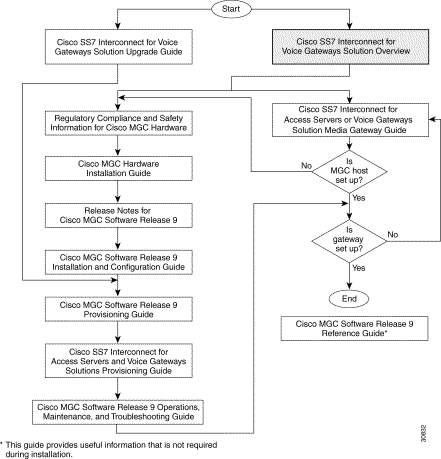|
|

This preface describes the objectives, audience, organization, and conventions of the Cisco SS7 Interconnect for Voice Gateways Solution. This document points to related publications and describes online sources of technical information.
The Cisco SS7 Interconnect for Voice Gateways Solution provides SS7 connectivity for voice gateways by using the Cisco signaling controller as a protocol translator to control the gateway through the ISDN Q.931 protocol.
This guide is designed to provide you with an overview of the Cisco SS7 Interconnect for Voice Gateways Solution and brief information about its components. This guide describes initial site preparation and implementation information with pointers to detailed hardware installation and software configuration documentation.
This document is part of a suite of documents for the following users. See the "Cisco SS7 Interconnect for Voice Gateways Solution Documentation Suite" section.
The major sections of this document are as follows:
| Chapters |
|
|
Cisco SS7 Interconnect for Voice Gateways Solution Introduction | Provides an introduction to the Cisco SS7 Interconnect for Voice Gateways Solution, describes architecture, benefits, features, and applications. | |
Cisco SS7 Interconnect for Voice Gateways Solution Configuration Options and Components | Provides information about configuration options and brief descriptions of components. | |
Cisco SS7 Interconnect for Voice Gateways Solution Operations | Describes unattended operations and manual control options. | |
Cisco SS7 Interconnect for Voice Gateways Solution Implementation | Provides sequence of implementation steps for the hardware connections and for installing software. Also, provides high-level component configuration steps with pointers to detailed documents. | |
Provides a brief overview of the SS7 technology used in this guide. | ||
Appendix B | Provides a brief overview of the VoIP technology used in this guide. |
Refer to the following documentation map to navigate through the Cisco SS7 Interconnect for Voice Gateways Solution documentation suite. Note that the shaded box indicates the document you are currently reading.

Refer to the following documents for detailed hardware and software installation and configuration information about the Cisco SS7 Interconnect for Voice Gateways Solution:
Command descriptions use the following conventions:
| |
| |
| |
| |
| |
| |
Screen examples use the following conventions:
| |
| |
| |
| |
| |
| |
| |
| |
Notes use the following conventions:
 |
Note Means reader take note. Notes contain helpful suggestions or references to material not covered in the publication. |
Cautions use the following conventions:
 |
Caution Means reader be careful. In this situation, you might do something that could result in equipment damage or loss of data. |
You can access the most current Cisco documentation on the World Wide Web at http://www.cisco.com, http://www-china.cisco.com, or http://www-europe.cisco.com.
Cisco documentation and additional literature are available in a CD-ROM package, which ships with your product. The Documentation CD-ROM is updated monthly. Therefore, it is generally more current than printed documentation. The CD-ROM package is available as a single unit or as an annual subscription.
Registered CCO users can order the Documentation CD-ROM and other Cisco Product documentation through our online Subscription Services at http://www.cisco.com/cgi-bin/subcat/kaojump.cgi.
Nonregistered CCO users can order documentation through a local account representative by calling Cisco's corporate headquarters (California, USA) at 408 526-4000 or, in North America, call 800 553-NETS (6387).
Cisco provides Cisco Connection Online (CCO) as a starting point for all technical assistance. Warranty or maintenance contract customers can use the Technical Assistance Center. All customers can submit technical feedback on Cisco documentation using the web, e-mail, a self-addressed stamped response card included in many printed docs, or by sending mail to Cisco.
Cisco continues to revolutionize how business is done on the Internet. Cisco Connection Online is the foundation of a suite of interactive, networked services that provides immediate, open access to Cisco information and resources at anytime, from anywhere in the world. This highly integrated Internet application is a powerful, easy-to-use tool for doing business with Cisco.
CCO's broad range of features and services helps customers and partners to streamline business processes and improve productivity. Through CCO, you will find information about Cisco and our networking solutions, services, and programs. In addition, you can resolve technical issues with online support services, download and test software packages, and order Cisco learning materials and merchandise. Valuable online skill assessment, training, and certification programs are also available.
Customers and partners can self-register on CCO to obtain additional personalized information and services. Registered users may order products, check on the status of an order and view benefits specific to their relationships with Cisco.
You can access CCO in the following ways:
You can e-mail questions about using CCO to cco-team@cisco.com.
The Cisco Technical Assistance Center (TAC) is available to warranty or maintenance contract customers who need technical assistance with a Cisco product that is under warranty or covered by a maintenance contract.
To display the TAC web site that includes links to technical support information and software upgrades and for requesting TAC support, use www.cisco.com/techsupport.
To contact by e-mail, use one of the following:
Language
| E-mail Address
|
|---|---|
| |
| |
| |
| |
| |
| |
In North America, TAC can be reached at 800 553-2447 or 408 526-7209. For other telephone numbers and TAC e-mail addresses worldwide, consult the following web site: http://www.cisco.com/warp/public/687/Directory/DirTAC.shtml.
If you are reading Cisco product documentation on the World Wide Web, you can submit technical comments electronically. Click Feedback in the toolbar and select Documentation. After you complete the form, click Submit to send it to Cisco.
You can e-mail your comments to bug-doc@cisco.com.
To submit your comments by mail, for your convenience many documents contain a response card behind the front cover. Otherwise, you can mail your comments to the following address:
Cisco Systems, Inc.
Document Resource Connection
170 West Tasman Drive
San Jose, CA 95134-9883
We appreciate and value your comments.
![]()
![]()
![]()
![]()
![]()
![]()
![]()
![]()
Posted: Wed Sep 6 08:23:12 PDT 2000
Copyright 1989-2000©Cisco Systems Inc.